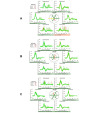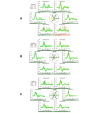Neurological and vestibular findings in three cases of Multiple Sclerosis
- PMID: 37991027
- PMCID: PMC10702714
- DOI: 10.1590/2317-1782/20232021153pt
Neurological and vestibular findings in three cases of Multiple Sclerosis
Abstract
Multiple sclerosis (MS) is a chronic and inflammatory autoimmune disease that affects the central nervous system (CNS). Dysfunction of body balance is also a common symptom and may be related to neurological injuries resulting from this disease. The aim of this study was to characterize the neurological and vestibular findings of three clinical cases diagnosed with MS. Data on the neurological evaluation and the magnetic resonance imaging of the skull were collected from the medical records. The patients responded to an initial interview and underwent clinical assessment of body balance and Video Head Impulse Test (vHIT). Vestibular symptoms and alterations were observed in at least one of the clinical tests of body balance and cerebellar function. In vHIT, changes were obtained in oculomotor tests, such as the presence of semi-spontaneous nystagmus and in parameters of the saccade test, and reduced gain in one or more vertical channels. Lesions were found on MRI of the skull in central areas that process vestibular information, such as the cerebellum and brainstem. The association of these findings suggests the presence of central vestibular dysfunction, compatible with the lesions detected in imaging exams.
A Esclerose Múltipla (EM) é uma doença autoimune crônica e inflamatória que afeta o sistema nervoso central (SNC). A disfunção do equilíbrio corporal também é um sintoma comum e pode estar relacionada às lesões neurológicas decorrentes desta doença. O objetivo deste estudo foi caracterizar os achados neurológicos e vestibulares de três casos clínicos com diagnóstico de EM. Dados sobre a avaliação neurológica e do exame de ressonância magnética de crânio foram coletados dos prontuários. Os pacientes responderam a uma entrevista inicial e foram submetidos à avaliação clínica do equilíbrio corporal e ao Video Head Impulse Test (vHIT). Observou-se presença de sintomas vestibulares e alterações em pelo menos uma das provas clínicas do equilíbrio corporal e função cerebelar. No vHIT, obteve-se alterações em testes oculomotores, como presença de nistagmo semi-espontâneo e em parâmetros do teste sacádico, e ganho reduzido em um ou mais canais verticais. Foram verificadas lesões, na ressonância magnética de crânio, em áreas centrais que processam as informações vestibulares, como cerebelo e tronco encefálico. A associação destes achados sugere a presença de disfunção vestibular central, compatível com as lesões detectadas nos exames de imagem.
RESUMO: A Esclerose Múltipla (EM) é uma doença autoimune crônica e inflamatória que afeta o sistema nervoso central (SNC). A disfunção do equilíbrio corporal também é um sintoma comum e pode estar relacionada às lesões neurológicas decorrentes desta doença. O objetivo deste estudo foi caracterizar os achados neurológicos e vestibulares de três casos clínicos com diagnóstico de EM. Dados sobre a avaliação neurológica e do exame de ressonância magnética de crânio foram coletados dos prontuários. Os pacientes responderam a uma entrevista inicial e foram submetidos à avaliação clínica do equilíbrio corporal e ao Video Head Impulse Test (vHIT). Observou-se presença de sintomas vestibulares e alterações em pelo menos uma das provas clínicas do equilíbrio corporal e função cerebelar. No vHIT, obteve-se alterações em testes oculomotores, como presença de nistagmo semi-espontâneo e em parâmetros do teste sacádico, e ganho reduzido em um ou mais canais verticais. Foram verificadas lesões, na ressonância magnética de crânio, em áreas centrais que processam as informações vestibulares, como cerebelo e tronco encefálico. A associação destes achados sugere a presença de disfunção vestibular central, compatível com as lesões detectadas nos exames de imagem.
Conflict of interest statement
Conflict of interests: nothing to declare.
Figures


Similar articles
-
Relationship between spontaneous nystagmus and video Head Impulse Test findings among patients with chronic neurotologic conditions.J Clin Neurosci. 2022 May;99:244-247. doi: 10.1016/j.jocn.2022.03.018. Epub 2022 Mar 15. J Clin Neurosci. 2022. PMID: 35304316
-
Relation of video-head-impulse test and caloric irrigation: a study on the recovery in unilateral vestibular neuritis.Eur Arch Otorhinolaryngol. 2014 Sep;271(9):2375-83. doi: 10.1007/s00405-013-2723-6. Epub 2013 Oct 6. Eur Arch Otorhinolaryngol. 2014. PMID: 24096811
-
Clinical and video head impulse test in the diagnosis of posterior circulation stroke presenting as acute vestibular syndrome in the emergency department.J Vestib Res. 2017;27(4):233-242. doi: 10.3233/VES-170620. J Vestib Res. 2017. PMID: 29081427
-
Measure of Central Vestibular Compensation: A Review.J Int Adv Otol. 2022 Sep;18(5):441-446. doi: 10.5152/iao.2022.21207. J Int Adv Otol. 2022. PMID: 35971266 Free PMC article. Review.
-
Video head impulse test: a review of the literature.Eur Arch Otorhinolaryngol. 2017 Mar;274(3):1215-1222. doi: 10.1007/s00405-016-4157-4. Epub 2016 Jun 21. Eur Arch Otorhinolaryngol. 2017. PMID: 27328962 Review.
References
-
- Marques VD, Passos GR, Mender MF, Callegaro D, Lana-Peixoto MA, Camini-Frota ER, et al. Brazilian consensus for the treatment of multiple sclerosis: brazilian academy of neurology and brazilian committee on treatment and research in multiple sclerosis. Arq Neuropsiquiatr. 2018;76(8):539–554. doi: 10.1590/0004-282x20180078. - DOI - PubMed
-
- Zuma e Maia FC, Carmona S, Costa SS. In: Otoneurologia atual. Zuma e Maia FC, Albernaz PLM, Carmona S, editors. Rio de Janeiro: Revinter; 2014. Avaliação clínica do paciente vertiginoso. pp. 25–51.
-
- Otometrics . ICS Impulse - Guia do Usuário. Dinamarca: Otometrics; 2016.
Publication types
MeSH terms
LinkOut - more resources
Full Text Sources
Medical

